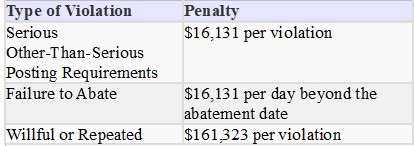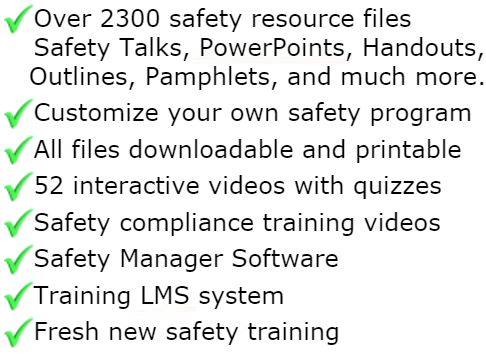
PSM - Process Safety Management
3 Parts to Process Safety
Process Safety Management (PSM) meet the requirements of OSHA Standard Process Safety Management of Highly Hazardous Substances.
Process Safety Information is the technical information on the process and equipment in the system. This information allows for accurate analysis.
Process Hazard Analysis and maintaining information on the system for operator training and reference.
PSM Program Required Elements
Introduction
Employee Participation
Process Hazard Analysis
Process Safety Information
Operating Procedures
Training
Pre-Startup Review
Contractors
Hot Work
Mechanical Integrity
Emergency Planning
Management of Change
Planned Maintenance
Although OSHA believes process safety management will have a positive effect on the safety of employees and will offer other potential benefits to employers, such as increased productivity, smaller businesses that may have limited resources to them at this time, might consider alternative avenues of decreasing the risks associated with highly hazardous chemicals at their workplaces. One method that might be considered is reducing inventory of the highly hazardous chemical. This reduction in inventory will result in reducing the risk or potential for a catastrophic incident. Also, employers, including small employers, may establish more efficient inventory control by reducing, to below the established threshold, the quantities of highly hazardous chemicals onsite. This reduction can be accomplished by ordering smaller shipments and maintaining the minimum inventory necessary for efficient and safe operation. When reduced inventory is not feasible, the employer might consider dispersing inventory to several locations onsite. Dispersing storage into locations so that a release in one location will not cause a release in another location is also a practical way to reduce the risk or potential for catastrophic incidents.
The various lines of defense that have been incorporated into the design and operation of the process to prevent or mitigate the release of hazardous chemicals need to be evaluated and strengthened to ensure their effectiveness at each level. Process safety management is the proactive identification, evaluation and mitigation or prevention of chemical releases that could occur as a result of failures in processes, procedures, or equipment.
The process safety management standard targets highly hazardous chemicals that have the potential to cause a catastrophic incident. The purpose of the standard as a whole is to aid employers in their efforts to prevent or mitigate episodic chemical releases that could lead to a catastrophe in the workplace and possibly in the surrounding community.
To control these types of hazards, employers need to develop the necessary expertise, experience, judgment, and initiative within their work force to properly implement and maintain an effective process safety management program as envisioned in the Occupational Safety and Health Administration (OSHA) standard.
Process Safety Management
Unexpected releases of toxic, reactive, or flammable liquids and gases in processes involving highly hazardous chemicals have been reported for many years in various industries that use chemicals with such properties. Regardless of the industry that uses these highly hazardous chemicals, there is a potential for an accidental release any time they are not properly controlled, creating the possibility of disaster. An effective Process Safety Management program can help prevent releases and prepare for emergency response in the event of a chemical release.g.
To help ensure safe and healthful workplaces, OSHA has issued the Process Safety Management of Highly Hazardous Chemicals standard which contains requirements for the management of hazards associated with processes using highly hazardous chemicals.
Process Safety Management is intended to prevent an incident like the 1984 Bhopal Disaster. A process is any activity or combination of activities including any use, storage, manufacturing, handling or the on-site movement of Highly Hazardous Chemicals (HHCs). A process includes any group of vessels which are interconnected or separate and contain HHC's which could be involved in a potential release. A process safety management incident is the "Unexpected release of toxic, reactive, or flammable liquids and gases in processes involving highly hazardous chemicals. Incidents continue to occur in various industries that use highly hazardous chemicals which exhibit toxic, reactive, flammable, or even explosive properties, or may exhibit a combination of these properties. Regardless of the industry that uses these highly hazardous chemicals, there is a potential for an accidental release any time they are not properly controlled by a properly designed Process Safety Management Program. This, in turn, creates the possibility of disaster.
A great many industrial facilities must comply with OSHA's Process Safety Management (PSM) regulations as well as the quite similar United States Environmental Protection Agency (EPA) Risk Management Program (RMP) regulations. The Center for Chemical Process Safety Management (CCPS) of the American Institute of Chemical Engineers (AIChE) has published a widely used book that explains various methods for identifying hazards in industrial facilities and quantifying their potential severity.
Hazardous chemical releases pose a significant threat to workers. The key provision of process safety management (PSM) is process hazard analysis (PHA), a careful review of what could go wrong and what safeguards must be implemented to prevent releases of hazardous chemicals. The following references
All materials in the members area for this topic index

GET INSTANT ACCESS
to THE MEMBERS LIBRARY
Safety materials created by safety professionals.
Access to the Safety Manager software.
Wide variety of safety videos and courses.
**Brand New** Safety Training Management System
Pre-Made Safety Materials Ready For Use
Created by experienced safety professionals & risk consultants. Saving you time, money, and risk of injuries.
95% of the work already done.
Below are the maximum penalty amounts, with the annual adjustment for inflation, that may be assessed after Jan. 15, 2024. (See OSHA Memo, Jan. 8, 2024).

**New OSHA HEAT 90 DAY**
>>Download Free HERE<<
**New 2024 OSHA 300 Form**
>>Download Free HERE<<
**Brand New**
Free with full membership subscription
Training LMS System
Ask The Safety Consultant
Safety Equipment Deal Finder

“SafetyInfo.com is the first go-to website for safety professionals and companies to use in establishing a solid safety program"
-Mike McKenzie, Certified Safety & Health Manager (CSHM), McSafety Solutions™
Note: You must have a full subscription to the Safety Library in order to use this material. Any use outside of your organization, for resell, or without an active membership is strictly prohibited and may result in prosecution under copyright infringement laws. Please contact us first, if you would be interested in reselling or using our materials for reproduction.
Inside the Members Library
Topic Index
Accident Prevention
Air Quality
Asbestos
Bloodborne Pathogens
Boilers
Chemical Safety
Compressed Gas
Confined Space
Construction
Construction Worksite
Cranes & Slings
Driver / Fleet Safety
Drug Free Workplace
Electrical
Emergency Management
Engineering Safety
Environmental
Equipment
Ergonomics
Fall Protection
Fire Safety & Prevention
First Aid
Flammable Materials
Forklifts
Hazard Communication
Hazardous Materials
Hearing Protection
Heat Stress
Hot Work
Housekeeping
Job Safety Analysis
Laboratory
Ladders
Lead
Lockout-Tagout
Machinery & Equipment
Material Handling
MSDS (SDS)
Medical & First Aid
Occupational Health
Office Safety
Off the Job Safety
Personal Protection
Process Safety
Record Keeping
Respiratory Protection
Silica Safety
Rules & Policies
Signs & Labels
Slips, Trips & Fall
Training
Terrorism Programs
Tool Safety
Vehicle & Driver
Violence Programs
Welding & Hot Work
Training Videos
Library Index
Training Materials
Videos/Courses
Talks
Articles
PowerPoint
Handouts
Training Overheads
Quizzes
Supervisor Briefs
Management Briefs
Safety Sessions
2 Minute OSHA Safety Talks
Pamphlets
First Aid Training
Supervisor Training
Hazardous Materials
Bomb Threat
Crossword Puzzles
Biological Agents
Forms & Documents
Forms
Checklists
Audit Guides
Inspections Guides
Signs & Labels
Environmental Audit Guides
Recordkeeping - OSHA 300
Sign & Label Maker
Safety Management Resources
Safety Manuals/Written Programs
Ergonomic Programs
Emergency Plans
Process Safety Management
Construction Safety
Occupational Health
Environmental
Topic Sheets
DOT Fleet-Driver
Hazardous Materials
Chemical Safety
Drug Free Workplace
Terrorism Programs
Development Guides
Safety Manager Software
Safety References & Graphics
Technical Safety Information
Posters
Topic & Fact Sheets
Development Information
Job Specific Safety Rules
Terrorism
Calculators
Safety Comic Strips
New Safety Training System
Schedule and train your employees with our materials. Add unlimited amount of employees. Record all progress and issue certificates. For group and individual training sessions.

